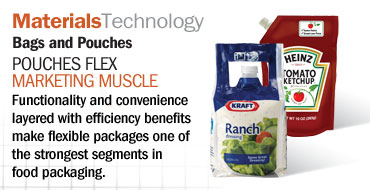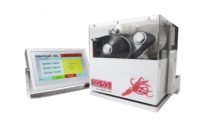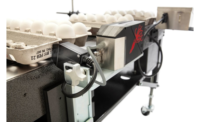
The flexible packaging market is so successful that many of the pouches literally stand up on their own, seemingly ready for a proverbial bow.
Pouches are in demand to the tune of 4.6% market growth yearly and projected to reach $8 billion in 2015, according to market research firmThe Freedonia Group, Inc.,(www.freedoniagroup.com) in a new study entitled Converted Flexible Packaging. Growth will be driven by:
• The continued conversions to stand-up pouches and healthy gains for flat pouches in a number of markets, along with a smaller environmental footprint due to lighter weight and reduced material use, which also holds down shipping costs; and
• The aging of rigid packaging equipment will create openings for replacements by pouch packaging equipment over the coming decade.
Converted flexible packaging demand in food applications is projected to climb 4.0% per year to $12.9 billion in 2015. The fastest gains are anticipated in beverage, meat and related products, and snack food applications.
To flesh out the numbers, we sought input from several well-placed managers throughout this segment of the market about trends and developments in bags and pouches.
Dan Bornemann, marketing manager,Bemis Flexible Packaging, Milprint Div.(www.bemis.com), continues to see growth in bags and pouches as more value-added features becoming the norm. “Consumers expect their products to be user friendly and expect the same with the packaging that holds and protects the products,” he says. “Ease-of-use such as opening and reclose features are becoming very common. Bags and pouches with dual compartments, boil-in bags, microwaveable pouches, and reclose features from zippers to spouts are examples of functionality and convenience. Another trend is retorted, shelf stable products, which are growing in demand. North America is lagging behind Europe and Asia regions in this category, but there is growth in both the human food and pet food markets.”
Product differentiation and point-of-purchase visibility remain a huge factor in the market, particularly for the repackaging of traditional commodity based or mature product categories, observes Dennis Calamusa, president,AlliedFlex Technologies(www.alliedflex.com). “Sustainability is also a continued driving factor, not only for environmental concerns, but also for the huge cost reduction due to the dramatic difference in logistics between rigid and flexible packaging.”
That fact gives flexibles an edge that itself is sustainable. “Improved logistics, as well as the huge potential cost saving, will continue to drive the flexible market for decades to come,” opines Calamusa.
That factor comes top of mind to Sal Pellingra,Ampac’s(www.ampaconline.com) director of innovation, who believes the high product:packaging efficiency of pouched formats will continue to drive growth.
“More traditional rigid packaging formats take up both space and weight,” Pellingra explains. “Even empty, rigids take up as much room as a filled package and are significantly heavier and thicker than flexible formats so they weigh significantly more. The increased space and weight impact the environment and cost. Moving from rigid to flexible can show an immediate impact on a reduction of packaging materials to a brand and its impact on the environment.
“In addition, pouches offer a more contemporary format that draws in younger consumers with unique graphics, shapes and styles. The ability to apply 360-degree graphics that stand out from other traditional formats grabs attention and increases sales.
“Lastly, flexible packaging compacts to take up less space, offering an advantage to the consumer even at the end of life as trash. Because of the significant reduction in packaging moving to flexibles, studies have shown that less packaging by weight enters the waste stream even when recycling is taken into consideration.”
What’s hot, what’s new?
Calamusa expects technologies to evolve as long as strong market growth continues, though he sees it as more evolutionary than revolutionary. “Most companies will not implement a replacement of their total production with flexible packaging, but supplement it with innovative flexible packaging value-added line extensions,” he says. He expects that spouted pouches will continue to penetrate traditional markets including baby food, condiments, beverages and others using both premade and form-fill-seal technologies, depending upon volume and core competency of the packager.
Nordenia U.S.A's. (www.nordeniausa.com) marketing coordinator Kevin W. Dorris commends the benefits of premade versus form-fill-seal pouches. “The main advantage is that converters are the experts in making preformed bags and the filling companies are the experts at their products they are putting into the bags,” he claims. “In [most] cases, you can also get more features by using a premade bag rather than a FFS line such as easy-carry handles, reclosure and easy opening. The quality and appearance of premade bags are typically better as well.”
One of the company’s latest innovations is the Nor®SpoutBag, which features a spouted pack with a handle. The fitment is integrated into the center of the pouch top to allow for a larger opening compared to conventional stand-up packs. It is available in sizes from ½ to 1 ½ gallon for products including food oils, sauce and ketchup.
The Milprint Division of Bemis recently applied for a patent for technology to provide Self-Venting Microwavable Stand-up Pouches for retorted products. The premade, stand-up pouches are converted with directed venting technology in the sides or the top of the pouch. It offers a controlled and directed release of the steam and pressure during microwaving. Additional functionality is available through “Cool Zones” on the pouch sides for safe handling coming out of the microwave and IntegraStart™ linear tear, an easy open feature for controlled and consistent opening across the top of the pouch.
Bornemann notes that this technology is so new that the company does not have any applications in the marketplace. “We are working with three large food companies on launches of new products in retort standup pouches at this time,” he adds. Those launches are expected in 2012.
Breakthroughs extend to the machines producing the popular preformed pouches, such as fromTotani America Inc.(www.totaniamerica.com). Totani’s Mike Greely, senior VP and sales manager, says the machines offer high-speed/high-efficiency features and data control systems. Greely notes that spouted alcohol pouches are especially popular in various formats including a conventional stand-up pouch or top- and bottom- gusseted pouch. Ampac’s new facility in Hanover Park, IL, purchased a Totani BH-60DG-F (SG-6) Box Pouch making machine, the third pouch format Ampac has added recently. The new machine provides Ampac with the first machine globally that has two-up Box Pouch capability and boasts technology that saves approximately 12% of the film required.
Another recent Ampac breakthrough is the No. 2 Pouch™, a stand-up pouch made primarily of high-density polyethylene to allow it to be marked with the desirable #2 recycle symbol and potentially be collected and recycled with grocery bags. “Recyclable packaging also is a much cleaner message to the brands and consumers rather than the confusion around compostable, degradable and renewable,” says Pellingra. Ampac has three commercial applications already and several more on the way.
Armed with marketing muscle and effective utility, flexibles represent a packaging format with strong “legs” going forward.


